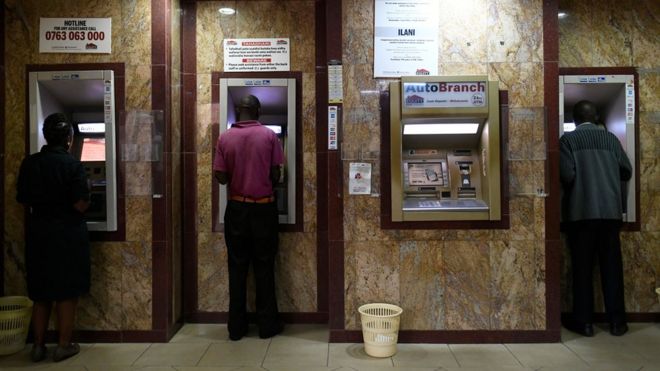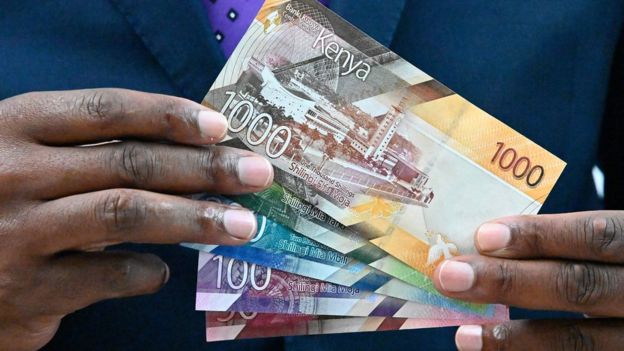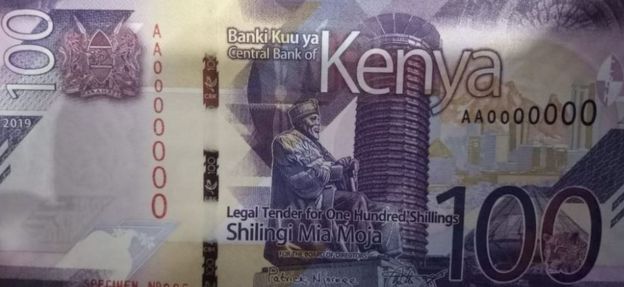 GETTY IMAGES
GETTY IMAGES
Kenya's President Uhuru Kenyatta has announced that the country's currency is to be replaced with a new generation of banknotes.
Kenyans must return their 1,000 shilling ($10; £8) notes to banks by 1 October, in a bid to fight money laundering, counterfeits and corruption.
New banknotes are to be brought in over the coming months with other denominations being phased out gradually.
Some Kenyans have expressed anger over the new banknote design, which features an image of a statue of Kenya's first President, Jomo Kenyatta - the current president's father.
The decision on the design, as well as the clampdown on the 1,000 shilling notes, has been challenged in court.
Why is Kenya replacing its banknotes?
Kenya is withdrawing the note to crack down on embezzlement and tackle a wave of counterfeit 1,000 shilling notes.
The governor of Kenya's central bank, Patrick Njoroge, also expressed "grave concern" over larger banknotes being used for "illicit financial flows in Kenya and also other countries in the region".
The 1,000 shilling note is the highest value note in Kenya and according to Mr Njoroge, the Kenyan shilling is the equivalent to the US dollar in east Africa, in terms of its recognition.
 GETTY IMAGES
GETTY IMAGES
President Kenyatta promised to stamp out corruption when he was elected in 2013.
But his critics say there have been few convictions since then, especially of high-profile people.
BBC Africa business reporter Georgie Ndirangu says the demonetisation - the withdrawal of a coin, note, or precious metal from use as legal tender - is seen as a direct response to this criticism.
Officials and well connected businessmen in corrupt cartels are believed to hold hundreds of millions of illegally obtained shillings in cash, and withdrawing the 1,000 shilling note is expected to close many money-laundering avenues, as they have to be exchanged for the new currency, he said.
How will the changeover happen?
Mr Njoroge said the four-month transition period should allow enough time for Kenyans to exchange their old 1,000 shilling notes.
Those exchanging less than 5m shillings would be able to do so at their local bank but any higher amounts will need approval from Kenya's central bank.
Mr Njoroge said he would be holding talks with managers of foreign-exchange bureaux and money-remittance providers to put in place controls to prevent illicit financial flows.
He said he would communicate with banks across the region so that illegal money did not get exchanged in their countries.
Why are Kenyans angry about the new currency?
As well as showcasing Kenya's wildlife, the new banknote design features the Kenyatta International Convention Centre (KICC) with a statue of Jomo Kenyatta in the middle.


He played a major role in leading Kenya to independence and went on to become the country's first president.
The Constitution of Kenya 2010 says that money - both coins and banknotes - should not feature a portrait of an individual.
Human Rights Activist Okiya Omtatah is challenging the decision in court, arguing that there has been a lack of public participation in designing the notes, as well as the demonetisation of the current 1,000 shilling note.
But some Kenyans back the decision to put Kenyatta on the note. One man said it was a "sign of respect" for the "founding father" of Kenya.
What other countries have demonetised?
In 2016, India changed almost all of its cash overnight, which some critics claim caused long-term financial problems. The Indian government said it was a necessary move to tackle tax evasion and terrorism funding, and in a country where 90% of transactions are in cash, to move towards a cashless society.
Nigeria introduced a similar ban on old notes in 1984 in an attempt to crackdown on corruption, as did Ghana in 1982 to help with tax evasion.
No comments:
Post a Comment